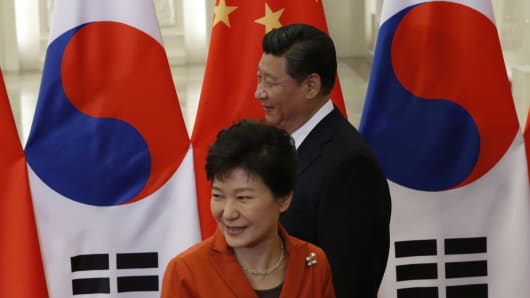And here is what that does: about half of South Korean economic growth over the last three years has come from net exports – i.e. from external demand.
That looks like a classic German recipe for prosperity on the back of your foreign customers with trade surpluses of 7-8 percent of GDP. The question is, though, why would South Korea - a country lucky enough to be beyond the reach of German austerity policies - do that to itself?
With the real short-term interest rate of about 1 percent, the Korean central bankers have room to ease and support their domestic spending. Inflation as a monetary phenomenon is the best proof of that. Consumer price increases have been more than halved to 0.7 percent in the year to June, and the official inflation target of 2.5-3.5 percent will now be undershot for the fourth year running.
Puzzling, isn't it? Especially since there is much more room to ease on the fiscal side.
A budget surplus of nearly 2 percent of GDP and no net public debt puts South Korea right along the energy-rich and investment-savvy Norway – a league of its own, far outclassing everybody else on the planet. There are plenty of resources here that can be deployed to rev up the sluggish domestic demand, and to support what Seoul calls its "creative economy." Tax cuts and strong public investments would support faster growth and promote South Korea's recently announced three-year program for "economic innovation."
Read MoreVicious South Korean family feud exposes chaebol peril
Adjusting the policy mix along these lines would stabilize output and employment; it would also wean this leading East Asian economy off its foreign trade gravy train.
China bears' wrong worries
China's trade surpluses are also racing to record-high levels. During the first quarter of this year, China's current account surplus soared 35 percent from the previous three months to almost $290 billion. That is mainly a result of the weakening domestic demand, a massive import substitution and expanding market shares of China's increasingly competitive exports.
I wonder whether China bears have thought of this. Instead of harping on such nonsense as an "imminent blowup of China's economy," a "bankrupt banking sector," "deadbeat local governments," "irretrievably crashing equity markets," – the bears could make a real contribution to the global welfare by harping instead on the fact that the world's second-largest economy should not be living off its trade partners. They should remember that these $290 billion – or China's astounding $540 billion trade surplus on goods trade – are other countries' deficits, i.e., subtractions from their economic growth.
Here is an example. In the first half of this year, China ran a $170.8 billion merchandise trade surplus with the U.S., a 10 percent increase from the year earlier. That accounted for 48.3 percent of America's total merchandise trade deficit. On current estimates of U.S. economic growth, it is quite possible that we shall contribute this year about 0.5 percent of our increase in domestic demand to the Chinese economy. That is how much our China trade will be a drag on our economic growth.
So, if China bears want something to worry about they should lament the fact that Beijing is not cutting further its interest rates (and its bank reserve requirements) to stimulate domestic spending. There is plenty of room to do that, because China's 2 percent real short-term interest rates are much too high for a slowing economy experiencing an inflation decline from 2.3 percent to 1.4 percent over the twelve months to June.
China has also quite a bit of room to step up its fiscal stimulus. The country's consolidated public sector accounts are roughly balanced, and its public debt is estimated at about 22 percent of GDP.
With all that money waiting to go to work, there is no shortage of shovel-ready infrastructure projects to sustain China's galloping urbanization. The good news is that higher public spending has been announced, and I hope that Beijing will deliver. It is expected that most of the planned investments will focus on transportation, water systems, education, healthcare and the environmental cleanup.
Read MoreChina's July exports slump 8%, raises pressure for more stimulus
A sustained pace of these infrastructure outlays will be critical in maintaining the economic activity over the months ahead. They should be offsetting the downward adjustment of excess capacities in real estate and in some segments of manufacturing industries.
Investment thoughts
I don't know whether China and South Korea will change the composition of their economic growth. I believe they should because an unnecessarily large reliance on trade surpluses makes their growth contingent on external demand – an economic variable they cannot control.
But whatever the case, I have shown that both countries have plenty of room to expand their monetary and fiscal policies. If they did that, they would boost their domestic demand and offer attractive equity market investments.
Whether that will happen or not depends partly on the IMF and countries most affected by deficits in their Chinese and Korean trades. Important economies, such as those of China and South Korea – you can throw Germany in there, too – should not be allowed to hold back the growth of world economy with their excessive trade imbalances.
The U.S. in particular should be quite concerned about that because its combined deficit with China and South Korea is currently running at an annual rate of $370 billion, or about 52 percent of America's total trade gap. Unless the women chase him out of the next GOP debate, you will probably hear Donald Trump screaming again "they are eating our lunch."
Michael Ivanovitch is president of MSI Global, a New York-based economic research company. He also served as a senior economist at the OECD in Paris, international economist at the Federal Reserve Bank of New York and taught economics at Columbia.





